
|
Sale 47
Pre-Long Beach Coin and Currency Auction
| Lot |
Photo |
Description |
Realized |
Lot 4879 |
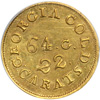 |
Christopher Bechtler, $2.50 GEORGIA, 64 gr. 22 carats. . K-11, Breen-7756. Rarity 6. PCGS graded MS-61. Uneven 22. Lovely shades of gold toning on both sides. Reflective surfaces. A lovely coin and one that is incredibly rare in this outstanding condition. Lustrous sleek surfaces with delicate toned highlights draw everybody's attention. Complete sharp details on the various legends and fineness descriptions, as well. A truly exquisite Mint State specimen of a rare $2.50 variety from the Southern coining facility of the Bechtler family.
In the words of Donald Kagin, "It is clear that several different finenesses of gold existed in the area. Georgia and central North Carolina gold was more yellow and pure than the gold of the mountain region and South Carolina. Bechtler is believed to have had a standard of seven shades of gold to help him determine fineness."
The Kagin reference goes on to say, "Bechtler made his own coining machinery, with the specie being stamped with the weight of the piece, its fineness in carats, and its dollar value. Bechtler's stated minting business practices displayed respectable integrity." And it is integrity we find in the quality and careful preservation of this rare surviving undated $2.50 gold piece struck by the Bechtlers sometime in the late 1830s. Pop 3; None finer at PCGS. (PCGS # 10073) .
Estimated Value $30,000 - 34,000.
View details and enlarged photos
Check results on similar lots
| Unsold |
Lot 4880 |
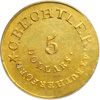 |
Christopher Bechtler, 5 DOLLARS GEORGIA, RUTHERF., 140 gr. 20 carats. . Kagin-17, Breen-7750, period after RUTHERF. PCGS graded MS-61. Lovely light golden toning and reflective surfaces on both sides. Diagnostic raised lump inside the 5, a feature of this die.
In 1834, Congress passed legislation reducing the gold content of America's gold coins. Christopher Bechtler prepared new dies engraved with the date "August 1, 1834" and began producing new coins with the reduced weight. These would be minted all the way to 1840, so the "1834" is merely a reference to the content change, not the date a particular coin was struck. Pop 2; 1 finer in 62. (PCGS # 10112) .
Estimated Value $28,000 - 30,000.
View details and enlarged photos
Check results on similar lots
| Unsold |
Lot 4881 |
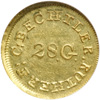 |
Christopher Bechtler, ONE DOLLAR N. CAROLINA, 28 gr. centered, no star. . Kagin-3, Breen-7747 "Very rare". NGC graded MS-61. Well struck and mostly untoed. The surfaces are prooflike. Bright light-golden luster on nicely reflective mint bloom. A touch of weakness and a "wavy" planchet that is normally seen on the commer varieties, is here nowhere to be seen. We do require mention of some minor adjustment-type marks along one portion of the rim at INA GOLD, possibly a minting artifact. An historic early Gold Dollar. The Federal government only experimented with making a gold dollar in 1836, yet did not strike one for circulation until 1849. However, from the 1830s well into the 1850s, the firm run by the Bechtler clan had one-upped the U.S. Mint and been striking this useful denomination for many years. Bechtler's coins circulated far and wide. They were accepted at par with regular United States coinage denominations and are mentioned in the economic histories of the time. Pop 4; 1 finer in 62. (PCGS # 10058) .
Historic reference: According to noted authority on Territorial Gold Coins, Donald Kagin, in his book "Private Gold Coins and Patterns of the United States," of all the private coiners, "Bechtler's operation was one of the fairest to the miners, as evidenced by the longevity of the mint (almost 20 years) and its substantial production (over $2 million).
"Having perceived a need for a smaller denomination, Bechtler issued the first $1 gold piece in the United States about the latter part of 1831. Another major modification in the Bechtler coinage occurred in 1834. That year Congress passed a bill reducing the gold content of our gold coins. Bechtler prepared new dies engraved with the date "August 1, 1834" and began producing new coins with the reduced weight.
"Bechtler coins appearing later in 1834 bore the words "NORTH CAROLINA GOLD, CAROLINA GOLD, and GEORGIA GOLD. Since there were three different purities and corresponding weights appearing on the $5 gold coins (20 carats-140 grains; 21 carats-134 grains; and 22 carats-128 grains) it is believed that the location inscriptions actually designated three different degrees of fineness, regardless of where the stamped gold was mined.
Estimated Value $18,000 - 20,000.
View details and enlarged photos
Check results on similar lots
| Unsold |
Lot 4882 |
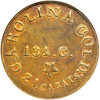 |
Christopher Bechtler, 5 DOLLARS CAROLINA, 134 gr. 21 carats, with star. . Kagin-20, Breen-7754. NGC graded AU-55. Lovely dark orange and gold toning. A well struck, carefully preserved coin from this important private minter.
This being one of the "Carolina Gold" issues, it is believed, according to the Kagin reference and earlier archival testimony, that the location inscriptions actually designated three different degrees of fineness, regardless of where the stamped gold was mined.
Kagin states that: A statement by the Acting Director of the Mint supports this theory: "Bechtler location stamps are only to assist in indicating the different qualities, as they are generally understood in that region, Georgia gold being usually the best and North Carolina the poorest." The stamped location on the coins generally corresponded with the three degrees of fine gold content and was at least equal to and usually exceeded the new United States standard (129 grains of .900 fine gold for $5). Confirmation on this point might be found in the Bechtler advertisement, wherein he offered to make special coins from "Georgia and South Carolina gold." An interesting era in American history! Pop 7; 26 finer; 11 in 58; 5 in 60; 10 in 61. (PCGS # 10097) .
Estimated Value $11,000 - 12,000.
View details and enlarged photos
Check results on similar lots
| Unsold |
Lot 4883 |
 |
Christopher Bechtler, 5 DOLLARS GEORGIA, RUTHERF., 128 gr. 22 carats. . Kagin-23, Breen-7760, colon after RUTHERF. PCGS graded AU-50. Lovely orange and gold toning. A light to medium golden example with some residual luster on both sides, nice clean surfaces, and best of all, grand eye appeal. The only mark of note is a short dash below the 1 of 128. A sharp strike on all devices. Pop 4; 6 finer; 1 in 53; 4 in 55; 1 in 61. (PCGS # 10109) .
Estimated Value $11,000 - 12,000.
View details and enlarged photos
Check results on similar lots
| Unsold |
Lot 4884 |
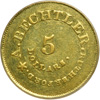 |
August Bechtler, 5 DOLLARS CAROLINA, 134 gr. 21 carats. PCGS graded AU-50. Kagin-20. Rarity-4. A nice example with some lustre still visable. And a rare survivor from an early period in America's numismatic heritage. Typical greenish-yellow color from the trace elements in the Carolina-mined alloy, with the surfaces showing only a few small abrasions from its short time in circulation. This is an affordable Bechtler $5 variety, one that will fit nicely into a Type Set of early U.S. gold struck by private (non-governmental) minters. Pop 13; 13 finer, 4 in 53, 7 in 55, 2 in 58 (PCGS # 10046) .
Estimated Value $10,000 - 11,000.
View details and enlarged photos
Check results on similar lots
| Realized
$11,213 |
Lot 4885 |
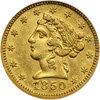 |
1850 Moffat & Co. (San Francisco) $5 Gold. NGC graded AU-58. A satiny, yellow gold beauty with strong "heavy" luster and a fashionably above-average strike. An unsung rarity among early Territorial half eagles, easily as popular as any privately minted coin in the series, and affordable as well. The 1850 date is typically found in worn grades, with AU coins being more unusual, and Mint State pieces being of creditable rarities. An outstanding AU58 representative example of the date, a coin with strong claims simply for its historical underpinnings. Opportunity knocks! Pop 9; 17 finer. (PCGS # 10243) .
Estimated Value $5,000 - 5,500.
View details and enlarged photos
Check results on similar lots
| Realized
$6,900 |
Lot 4886 |
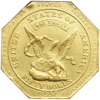 |
1851 U.S. Assay Office $50 "slug", 887 THOUS. Reeded edge. NGC graded MS-60. Untoned with nice details. This example, illustrative of the Mint State quality (only rarely seen) in its grade class, has brilliant light golden color, frosty surfaces that have a somewhat granular effect from the dies and no toning or alloy spots. The strike is medium-strong for the date, with just brief softness at the eagle's breast and tail as well as the leg. Also, some of the outer legend is a little indistinct from the grainy appearance of the luster. It reads: AUGUSTUS HUMBERT UNITED STATES ASSAYER OF GOLD CALIFORNIA 1851.
The U.S. Assay Office would produce what became the highest denomination U.S. gold coin to circulate -- octagonal-shaped $50 gold coin-ingots, often referred to as "slugs." On the reverse, the design appears as a series of concentric circles in the center, surrounded by overlapping lines or perhaps a better way of putting it is a series of wavy, concentric circles (found on the reeded edge slugs). These concentric circular lines are known to mechanics as "engine turning,", the design is similar to the web-like engraving in the vignettes on paper money or on watchcases, and unique to Territorial Gold struck at the Assay Office of Gold in the early years of the Gold Rush. A rare Mint State offering of one of these. Pop 2; 16 finer; 7 in 61; 4 in 62; 5 in 63. (PCGS # 10214) .
Estimated Value $70,000 - 80,000.
View details and enlarged photos
Check results on similar lots
| Unsold |
Lot 4887 |
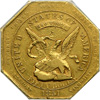 |
1851 U.S. Assay Office $50 "slug", 880 THOUS. Reeded edge. NGC graded EF-40. Well struck with light natural toning on both sides. A popular coin. Indeed, a coin of majestic dimensions, this is a famous Territorial issue. Assay pieces were coined by the forerunner of the San Francisco Mint. The design details are nicely displayed, and the overall eye appeal is consistent with the EF40 grade. Of course, as typical for these large coins, some scattered circulation marks and contact points on the corners may be observed, including a mark under the fineness ribbon on the obverse, but the surfaces are far nicer than might be expected considering the yeoman duty these slugs performed. With the coin offered in this lot, we can without hesitation that it is a very desirable showpiece for the numismatist. Pop 5, 31 finer (PCGS # 10211) .
Estimated Value $20,000 - 22,000.
View details and enlarged photos
Check results on similar lots
| Realized
$24,725 |
Lot 4888 |
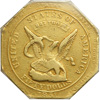 |
1851 U.S. Assay Office $50 "slug", 887 THOUS. Reeded edge. PCGS graded VF-25. Nice even wear. Mostly untoned with the central legends and the date plain, but some of the outer legend at left indistinct. No deep digs or gouges as on some slugs, the coin is accurately graded and, for its weight, size, and historic connections, quite attractive (PCGS # 10214) .
Estimated Value $17,000 - 18,000.
View details and enlarged photos
Check results on similar lots
| Realized
$20,700 |
Lot 4889 |
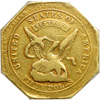 |
1851 U.S. Assay Office $50 "slug", 887 THOUS. Reeded edge. PCGS graded Fine-15. A pleasing coin for the grade, the corners, while not exactly sharp, do show decent cornering. Most of the inner legend is crisply definied; some of the outer legend nearest the edge (which tends to receive the bulk of any circulation wear) is no longer readable. The upper portion of the date is readable on this historic Territorial gold piece (PCGS # 10214) .
Estimated Value $13,000 - 14,000.
View details and enlarged photos
Check results on similar lots
| Unsold |
Lot 4890 |
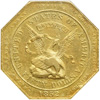 |
1852 U.S. Assay Office $50 Gold, 887 THOUS. NGC graded MS-60. Lovely light golden toning on both sides. Some luster still evident. A brilliant and highly lustrous $50 slug that has typical preserved surfaces. It is often noted by numismatists that this issue is easier said than done to find fully struck. The centers pack full detail into the eagle design from a decidedly precision strike, with only marginal strike softness at the upper part of the shield, leg and claw. The wings and scroll show excellent detail, as does all lettering in the legends.
The latter style of $50 "slug" has a reeded edge (earlier ones carried lettered edges) and is struck from a die pair not involving individual processes (as in the complicated creation of the lettered edge pieces). The present piece shows luster in the form of light frost and the surface has some typical stray marks. This is the 887 THOUS variety. Why not "coin standard" .900 Fine? The necessity of the additional refining effort required to bring the melt up to standard would have been prohibitive in this early period (though it was accomplished later). The reverse, as in the previous 1851-dated piece displays the engine-turned design, sometimes attributed to Augustus Humbert who once made watch cases (presumably with engine themselves).
The $50 octagonal "slug," was a mainstay of California business transactions in the first years of Statehood. They were employed in large transactions, being the best coin of choice in a region of the country that had a dearth of circulating specie. It should also be noted that paper money was prohibited in California (under the Constitution of 1850), so until sufficient lesser denomination gold coins were made, these 2-1/2 ounce behemoths would have to do. Pop 2; 5 finer; 2 in 61; 3 in 62. (PCGS # 10016) .
Estimated Value $90,000 - 110,000.
View details and enlarged photos
Check results on similar lots
| Unsold |
Lot 4891 |
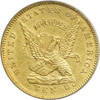 |
1853 U.S. Assay Office $10 Gold, 900 THOUS. . Kagin-16, Breen-7720 "Struck March-April 1853." PCGS graded MS-60. Well struck and untoned. A frosty coin with a few light signs of contact. A fully struck example in fresh Mint condition with a light overlay of gold color. Close examination reveals some greenish accents. Struck with exactitude by the dies, all features on the eagle are incredibly detailed. This continues with the shield (rarely this bold), where the vertical stripes all show and the arrow tips can be seen individually. Outstanding detail! Destined for a fine collection. Pop 1; 8 finer; 1 in 61; 3 in 62; 4 in 63. (PCGS # 10007) .
Estimated Value $17,000 - 18,000.
View details and enlarged photos
Check results on similar lots
| Unsold |
Lot 4892 |
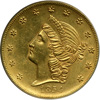 |
1854 Kellogg & Co. (San Francisco) $20 Gold. PCGS graded MS-61. A boldly struck coin. Lightly toned. Sleek golden in color seesaws with an occasional hint of greenish yellow toning, the surface condition causes us to commend the coin to one and all since it escaped the usual heavy bagmarking and alloy-impurity streaks seen on many Territorial issues. The hallmark of Kellogg & Company coins is their sharp detail and accurate images that borrowed from the regular Federal gold coins. Much as the luster is superior in so conservative a grade as Mint State 61, so too is the strike: the dies left their rigid impression behind with clear precision, indeed, incredible precision when one accounts for the stars, the waves of hair, the coronet and its lettering, and the Kellogg rendition of the standard ornate reverse. The capacity of minting done by the Kellogg people was remarkable in its day. Sadly, many of these handsome, private $20 gold pieces were eventually melted and sent to the San Francisco Mint for recoinage into standard U.S. gold denominations. Recently graded and new to the PCGS Population Report. Pop 4; 3 finer; 2 in 62; 1 in 64. (PCGS # 10222) .
Estimated Value $22,000 - 24,000.
View details and enlarged photos
Check results on similar lots
| Unsold |
Lot 4893 |
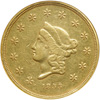 |
1855 Wass, Molitor & Co. (San Francisco) $50 Gold. NGC graded AU-53. Untoned with the normal amount of light ot moderate bag marks. Upon arriving in California the partners of this firm operated a private mint and assay office that struck $10, $20, and $50 gold pieces. The $50 pieces follow closely the theme on the Federal $20 gold Liberty coins of the day; as a $50 denomination in a time of dire need for a circulating medium, the coins were acceptable to the populace. As the only round $50 gold pieces issued in California, they found acceptance elsewhere and circulated in other regions of the Western United States. Evidently, their round shape (and the availability of lower denominations from the same firm) made them as acceptable as the $50 slugs of Humbert and the U. S. Assay Office. The Alta California reported that $38,000 of these fifties and twenties were produced in a day.
This nicely balanced AU53 example shows clear striking details on the date and stars plus the legends of the reverse. There is a little luster left, and smooth and mostly mark-free look covering the entire surface including Liberty's cheek contour. We do note a few nicks in the field before the face. Liberty herself proudly displays full sharp hair and a nicely curved, if slightly rounded coronet edge. The reverse has typical, but again small, circulation abrasion from the time it spent as a method of payment. Unlike other $50 gold coins by Wass, Molitor, this piece lacks heavy cuts on the rims. The reverse takes over from where the obverse left off in being not only sharp throughout (including the wreath) but also, attractive enough that bidders will want to own it in a heartbeat! The coin is housed in NGC holder 1921836-005 and will likely prove to be one of the Star Attractions in its new home. Pop 3; 14 finer. (PCGS # 10363) .
Estimated Value $70,000 - 80,000.
View details and enlarged photos
Check results on similar lots
| Unsold |
Lot 4894 |
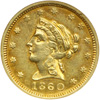 |
1860 Clark, Gruber & Co. (Denver, Colorado) $2.50 Gold. NGC graded MS-63. Lovely golden toning on both sides. A very choice example of this scarce Colorado Territory issue, struck on a perfect light greenish gold planchet, the luster fresh and original with natural aging. The strike is better overall than average for the issue, with high rims and complete dentils, while the devices are only slightly rounded and about typical for this issue. The softness is found at the centers on both sides, but to be fair, this is not unexpected. Any marks are limited in size and are few, we note a small rim indentation between stars 8 and 9 on the obverse and an equally meaningless hairline in the field between the words PEAK and GOLD on the reverse. All in all a gorgeous Mint State 63 specimen we believe discriminating collectors will find attractive.
Clark, Gruber & Co., Leavenworth, Kansas bankers, formed a branch of their establishment in Denver after gold was discovered in the region in the 1850s. Clark, Gruber became the largest mint in the Territory. Its operation would subsequently form the basis for the Denver Mint government mint. Pop 4; 3 finer; 1 in 64; 2 in 65 (PCGS # 10135) .
Estimated Value $15,000 - 17,000.
View details and enlarged photos
Check results on similar lots
| Unsold |
|
|